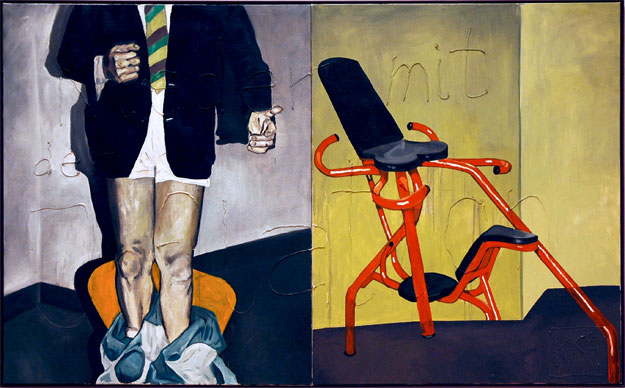
Martin Kippenberger Down with inflation 1984 oil and silicone on canvas (2 parts) 63" x 104.75" each
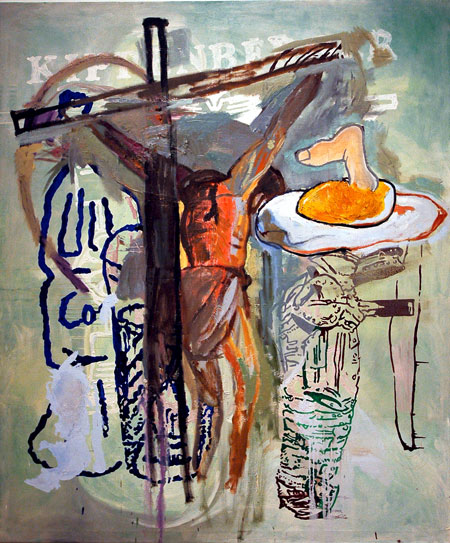
Martin Kippenberger Untitled, from the series Fred the Frog 1990 oil on canvas 94.5" x 78.75"
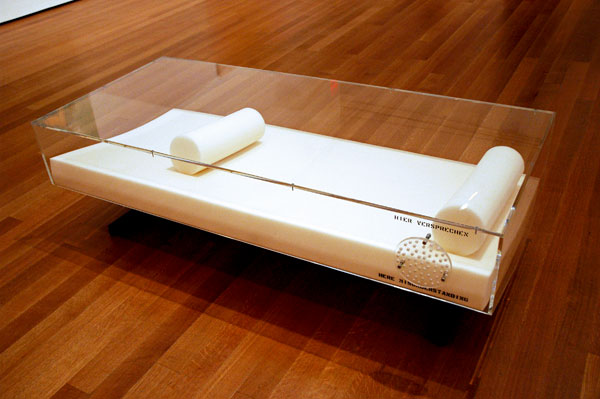
Martin Kippenberger Snow White's Coffin* 1989 Plexiglas, synthetic foam and metal 15.75" x 33.5" x 71"
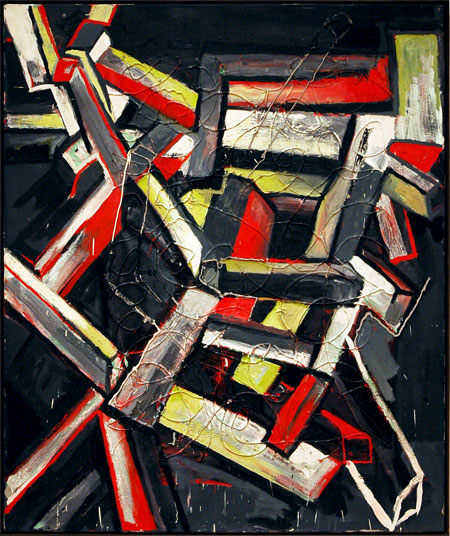
Martin Kippenberger With the Best Will in the World I Can't see a Swastika 1984 oil and silicone on canvas 63" x 52.75"
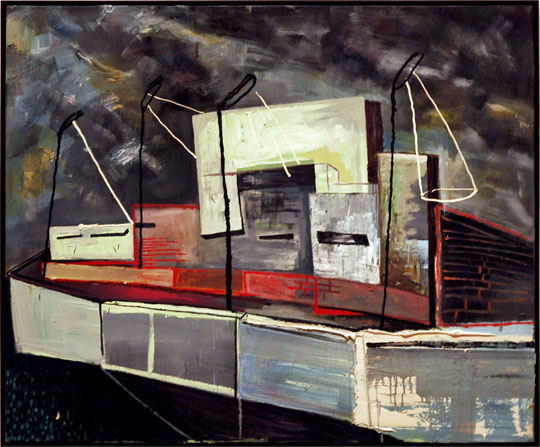
Martin Kippenberger "Stammhelm"** from Three Houses with Slits (betty Ford Clinic, Stammheim, Jewish ELementary School) 1985 oil and lacquer on canvas 49.5" x 59" each
This one really is for us. I mean the glorious, rich show, "Martin Kippenberger: The Problem Perspective", which will open on Sunday (March 1) at MoMA. And I mean that it's especially appealing to us art junkies: artists, fans and whatnots, zealots who regularly traipse through some of our meaner streets, searching out, and even haunting the more adventurous galleries and grittier rooms in this city and the incredible world beyond it, looking for the real thing, art which both reflects and challenges a world unlike that of even the most recent past. An anomalous rabble, we're notorious (or more often ignored) for being sustained by under-known art not yet "elevated", even made sacred, by the respectable museums we're just not visiting so much any more (and not only because admission to the pantheon can set us back twenty bucks a pop).
But today I feel much better about the Museum of Modern Art than I have for some time.
Because of our interest in the subject of the retrospective, and our relative ignorance of it, Barry and I were eager to go to the press preview on West 53rd Street even though it was scheduled for something like our dawn this morning. I'm delighted to see that this month our local cabinet of early-modern curiosities is bringing us both Klara Liden (opening tomorrow, February 25), and the Kippenberger show, although I have to point out that the Kippenberger was put together by The Museum of Contemporary Art, Los Angeles [MOCA], Ann Goldstein, curator.
It's a great show.
This is a collection of work which passes back and forth (sometimes doubling and tripling up) in what seems to include just about every medium. Although it all really looks like today, some of the pieces being displayed have been around for three decades. A few of the articles installed in the museum's sixth-floor Special Exhibiton Galleries may be little more than the size of a hand, and the paintings are generally less than gigantic, but there are also room-size pieces, and one installation, "The Happy End of Franz Kafka's 'Amerika'", which totally fills the bottom of the huge atrium, leaving only a modest square path lining its sides for all the visitors it will delight.
In her remarks today Ann Goldstein shed some light on the title of the retrospective (still slightly obscure to me, since I haven't yet read all the material handed out at the presentation) when she described Kippenberger as a "profoundly productive problem maker". I was suddenly all ears - or, in this case, all eyes.
Because of its inherent strength, its enormous influence on other artists, and the fact that, as Goldstein also said, we've finally begun to catch up with Kippenberger, I think by now we would probably be seeing this body of work in these major, established settings in some form even if the artist had not died so young, in 1997, of cancer. He should be turning 56 tomorrow, February 25. I can't imagine what our world would look like if we were lucky enough to still find ourselves provoked, repeatedly, by the wisdom, the humor and the irreverence of this prolific virtuoso.
Now the work he has left us looks like it's here for the ages, whatever that may mean, but I have to hope "the ages" will always cultivate the liberality which Kippenberger's art seems to ask of us.
It's a totally delightful show, great fun and without a dull note. I will be visiting it as often as I can while it's still here in New York.
The choice of the images uploaded here [yes, they're mine; fortunately we were allowed to take photos, since the museum seems to have virtually nothing on their site yet] was necessarily impacted by my fast run through the galleries during a far-too-brief press preview this morning, and it therefore doesn't necessarily represent either a good overview of the installation itself or a list of my top favorites - if any arrangement of either were even possible.
*
the German text above the perforated opening translates literally as "here promise"; the English text below it reads "here misunderstanding"
**
Stammheim Prison, where the leading members of the Red Army Faction (Baader-Meinhof) were held and tried. It is also the site where four of them either committed suicide or were murdered - extrajudicially.